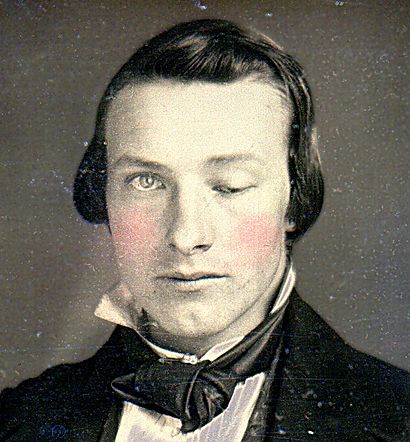Ptosis (eyelid) facts for kids
Quick facts for kids Ptosis of the eyelids |
|
|---|---|
 |
|
| Ptosis of the left eyelid (unilateral ptosis). A headshot daguerreotype of an unidentified male, by William Bell in 1852. |
Ptosis (say: TOE-sis), also known as blepharoptosis (say: BLEF-uh-rop-TOE-sis), is when your upper eyelid droops or falls down. It can happen to one eye or both. This drooping might look worse when you are tired, like after being awake for a long time.
Sometimes people call ptosis "lazy eye," but that term usually means a different eye condition called amblyopia.
Contents
What is Ptosis?
Ptosis is a medical condition where the upper eyelid hangs lower than it should. This can make it harder to see clearly. It can also make a person look sleepy or tired.
Why Does an Eyelid Droop?
Your eyelids move up and down thanks to special muscles. The main muscle that lifts your eyelid is called the levator palpebrae superioris muscle. If this muscle or the nerve that controls it isn't working right, your eyelid can droop.
Types of Ptosis
Ptosis can be different for different people. It can be mild, meaning the eyelid droops only a little. Or it can be severe, where the eyelid covers most of the eye.
Congenital Ptosis
Some people are born with ptosis. This is called congenital (say: kon-JEN-ih-tal) ptosis. It happens when the eyelid muscle doesn't develop properly before birth.
Acquired Ptosis
Other people develop ptosis later in life. This is called acquired ptosis. Many things can cause it, such as:
- Aging: As people get older, the eyelid muscles can stretch or weaken.
- Injury: An injury to the eye or head can damage the eyelid muscles or nerves.
- Nerve problems: Conditions that affect the nerves controlling the eye muscles can cause ptosis.
- Muscle diseases: Some diseases can weaken muscles all over the body, including those in the eyelids.
- Eye surgery: Sometimes, ptosis can happen after eye surgery.
How Ptosis Affects People
The main problem with ptosis is that it can block your vision. If your eyelid covers part of your pupil (the black center of your eye), it's like looking through a curtain. This can make it hard to read, drive, or do other daily activities.
It can also cause other issues:
- Head tilt: Some people with ptosis might tilt their head back to see better.
- Eyebrow strain: They might also try to lift their eyebrows to raise their eyelids.
- Eye strain: Constantly trying to see around the drooping eyelid can make eyes feel tired.
Famous Examples of Ptosis
You might be surprised to learn that some famous people throughout history have had ptosis.
- King Edward I of England: This king, who lived in the 13th and 14th centuries, had ptosis. Artists even showed it in his portraits. He inherited it from his father, King Henry III.
- Phineas Gage: After a serious accident in 1848 where an iron rod went through his head, Phineas Gage developed ptosis in one eye.
- Forest Whitaker: This well-known Hollywood actor has ptosis in his left eye.
Treatment for Ptosis
If ptosis is mild and doesn't affect vision, it might not need treatment. However, if it blocks vision or causes other problems, there are ways to help.
- Surgery: The most common treatment is surgery. A surgeon can tighten the levator muscle or reattach it to help lift the eyelid.
- Special glasses: Sometimes, special glasses with a "ptosis crutch" can help hold the eyelid up. This is a small attachment on the glasses frame that supports the eyelid.
The best treatment depends on what caused the ptosis and how severe it is. A doctor who specializes in eyes (an ophthalmologist) can help decide the right plan.
Images for kids
-
Early fourteenth-century manuscript initial showing King Edward I of England and his wife Eleanor of Castile. The artist has depicted Edward's blepharoptosis, a trait he inherited from his father, King Henry III.
-
Neurotoxic ptosis caused by botulinum toxin: a 14-year-old botulism patient with bilateral total ophthalmoplegia with ptosis (left image) and dilated, fixed pupils (right image). The teenager was fully conscious
-
Hollywood actor Forest Whitaker has a left eye ptosis
See also
 In Spanish: Ptosis palpebral para niños
In Spanish: Ptosis palpebral para niños






